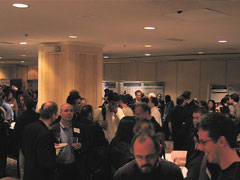Imaging Success: Sunnybrook Drives ImNO Symposium to New Heights
By Jim Oldfield
For most people, an academic symposium on medical imaging conjures up a nebulous picture of mingling researchers talking shop and downing stale java between impenetrable (to most of us) lectures. In fact, most academic conferences fall somewhere between this and the recent Imaging Network Ontario (ImNO) symposium, a rousing success. The symposium drew the largest audience since its 2001 start and generated genuine excitement among scientists and students, as well as current and potential industrial partners.
“One is really getting a sense of an established forum, where people come for the purposes of networking and discussion,” says Graham Wright, senior scientist at Sunnybrook Research Institute (SRI) and project leader of the Ontario Consortium for Cardiac Imaging. “A lot of interesting ideas are put forward, so I think it has definitely been a productive enterprise to date,” he says.
Support from the Ontario Research Fund
The symposium brings together five consortia — groups of scientists working in specific areas of imaging research and funded by the Ontario Research and Development Challenge Fund, now the Ontario Research Fund-Research Excellence (ORF-RE). These are the Behavioural Research and Imaging Network, the Ontario Centre of Excellence for Breast Cancer Imaging Research, the Ontario Consortium for Cardiac Imaging, the Ontario Consortium for Image-Guided Therapy and Surgery, and the Ontario Consortium for Small Animal Imaging. The symposium facilitates interaction among scientists, engineers, physicists, students, fellows and industry reps (matching investments from industry are a requisite component of all grants from ORF-RE) through presentations over two days at the University of Toronto.
Enthusiastic students compliment Sunnybrook
Rahul Sarkar, an imaging co-op student at SRI, says, “This was the first conference I’ve ever been to, so it was really cool getting a sense of how people come together and share research. Each presentation was short, and most of them were accessible, so it gave a wide exposure to the field very quickly.” He and another co-op student, Anne Hsieh, are enthusiastic about the prospect of attending next year.
They also praised Sunnybrook for its organization and support of the conference. The event involves groups from across the province, but the special projects office at SRI coordinates it. Wright seconds those compliments: “Our institute’s role within ImNO has been pivotal in organizing these symposia. We coordinate the various scientific committees, organize the structure of the event and make it all come together.”
In addition, SRI scientists and their lab teams are active in all five consortia. They accounted for one-quarter of the more than 400 participants at this year’s event, by far the largest contingent from a single institute.
SRI's new director of imaging delivers keynote address
Michael Julius, vice-president of research at Sunnybrook Health Sciences Centre, introduced the keynote speaker, Kullervo Hynynen. Recently recruited from Harvard University, Hynynen is the new director of imaging research at SRI and a Canada Research Chair in Imaging Systems and Image-Guided Therapy. Hynynen’s talk held a captive audience as he outlined his pioneering research in the use of ultrasound as a noninvasive surgical and therapeutic technique capable of dissolving uterine fibroids and even brain tumours while, incredibly, leaving surrounding tissue intact.
That talk was one of many over the days that showcased truly leading-edge innovation and results that have emerged from SRI projects. As Julius says, “Our representation at ImNO reflects the quality of imaging research at SRI. Our imaging scientists are Canadian — and indeed world — leaders, and were essential to the fantastic success of this year’s ImNO symposium.”
Special thanks to Christine Sudeyko and the special projects office at SRI for coordinating this year’s ImNO event with colleagues at the Rotman Research Institute, John P. Robarts Research Institute and University Health Network. The Ontario Research and Development Challenge Fund partners funded the symposium.
PDF / View full media release »





